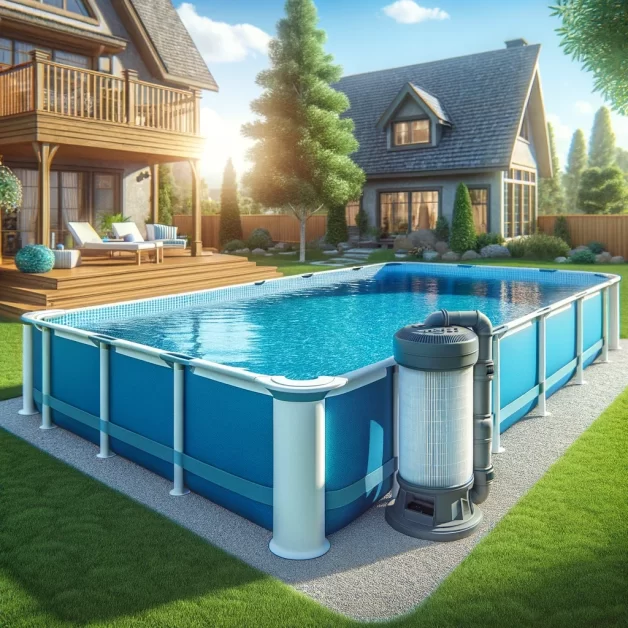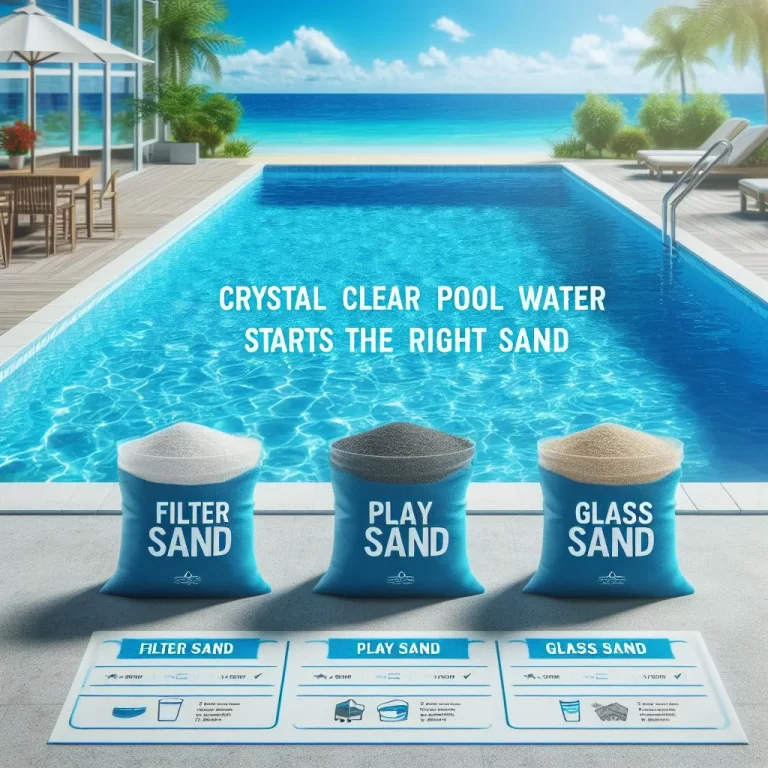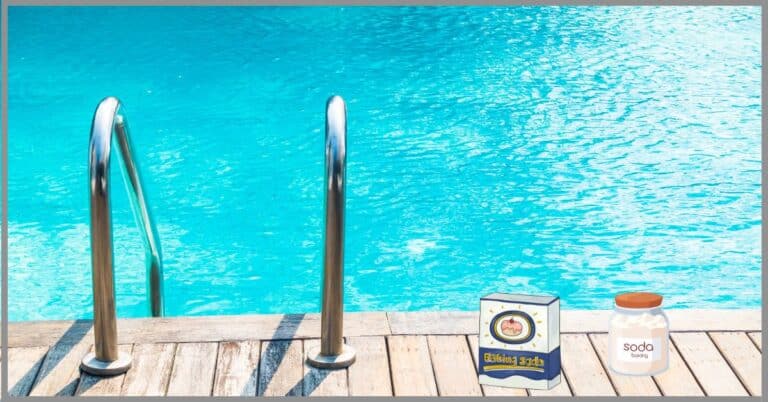Unlocking the Mystery: The True Pros and Cons of Sand Filters
Explore the pros and cons of sand filters in our comprehensive guide. Get informed before your next purchase!
Imagine sipping a glass of clear, refreshing water – it’s pristine, pure, and free from any impurities; you’d likely attribute this purity to sophisticated modern technology. But would you believe that one of the oldest forms of purification involves something as simple yet effective as sand?
Choosing the right filtration system is crucial when maintaining a clean and inviting hot tub. Among the various options available, sand filters are a popular choice for many hot tub owners.
In this article, we’ll explore the pros and cons of sand filters to help you determine if they are the right fit for your Hot Tub Patio.
Understanding Sand Filters
Don’t underestimate humble sand! In sand filters, it’s the secret weapon against murky water. These workhorses act like super sieves, trapping dirt and debris from pools, spas, and wastewater.
But how do they know they’re full? That’s where understanding comes in. As more junk gets caught, pushing water through gets tougher. Think of it like a clogged drain – a sign it’s time to clean or “backwash” the filter. This isn’t a weakness; it’s a badge of honor!

Sand Filter Secrets: How They Keep Your Water Sparkling
Sand filters might seem ordinary, but they’re quietly working behind the scenes to keep your pool water crystal clear. Their secret lies in a simple yet powerful combination of sieving, trapping, and natural magic.
Imagine pouring dirty water through a tower of fine sand. That’s basically what happens in a sand filter. As the water trickles down, the tiny sand grains act like microscopic sieves, grabbing dirt and debris like a kid collecting seashells.
But there’s more to it than just sand! Over time, a thin layer of invisible helpers grows on the sand called a biological film. These microscopic organisms are nature’s tiny janitors, munching away on any leftover germs and keeping your water even cleaner.
So, the next time you dip in your clear blue pool, remember it’s not just chlorine doing the hard work. These silent sand-dwelling superheroes quietly filter and scrub to keep your water safe and sparkling.
Pros of Sand Filters
- Effective Particle Filtration: Sand filters are highly effective at filtering out small particles from the water. This results in more precise, cleaner water, essential for a pleasant hot tub experience. But what happens if you notice your pool filter is blowing out sand? This resource explains potential issues and fixes.
- Low Maintenance: One of the most significant advantages of sand filters is their low maintenance requirements. Typically, they need to be cleaned every few months, which involves backwashing. This is relatively easy to do and does not require replacing the filter.
- Longevity: Sand filters have a long lifespan. The sand in the filter usually needs to be replaced only every 5 to 7 years, making it a cost-effective option in the long run. This is particularly beneficial for regular hot tub users, as our maintenance guide highlights.
- Eco-Friendly: Sand is a natural and abundant material, making sand filters eco-friendly. Furthermore, the infrequent need for replacement reduces waste, aligning with sustainable practices.
Cons of Sand Filters
- Limited Filtration of Oils and Lotions: While great for particles, sand filters are less effective at filtering out oils, lotions, and other organic materials that can get into hot tub water. This might require additional chemical treatments to keep the water balanced. Understanding the different types of pools can help you choose the best one for your filter’s efficiency.
- Requires Space: Sand filters are typically larger than other types of filters, such as cartridge filters. This might be a consideration if your hot tub area has limited space. Our feature on maximizing patio space provides excellent tips for dealing with spatial constraints.
- Initial Cost: The upfront cost of a sand filter can be higher than other types of filters. However, this should be weighed against the long-term savings due to its durability and low maintenance requirements.
- Water Consumption for Backwashing: Backwashing a sand filter requires significant water to clean it. This may be a concern in areas where water conservation is a priority. For more tips on eco-friendly hot tub practices, visit our page on sustainable hot tubbing. Additionally, proper sand filter cleaning tips can help you minimize water usage.
Comparing Sand Filters to Other Systems
Sand Filters vs. Cartridge Filters
| Feature | Sand Filters | Cartridge Filters |
|---|---|---|
| Filtration Quality | Effective for small particles, resulting in clear water. | Higher filtration capability, can capture finer particles. |
| Maintenance | Backwashing required every few months; sand replacement every 5-7 years. | Frequent cleaning needed; cartridge replacement every 1-3 years. |
| Cost | Higher initial cost; lower long-term maintenance costs. | Lower initial cost; ongoing cost of cartridge replacements. |
| Water Usage | Significant water use due to backwashing. | More water-efficient as no backwashing is needed. |
| Ideal for | Those who prefer less frequent maintenance interventions. | Those looking for finer filtration and conserving water. |
Sand Filters vs. Saltwater Systems
| Feature | Sand Filters | Saltwater Systems |
|---|---|---|
| Chemical Use | May require more chemicals to manage oils and lotions. | Uses salt to naturally generate chlorine, reducing added chemical needs. |
| Complexity | Simpler design, generally easier to troubleshoot. | More complex systems, can be more expensive to repair. |
| Feel of the Water | Standard water feel, may require more chemicals for balance. | Softer, smoother water feel with less noticeable chlorine. |
| Ideal for | Those looking for simplicity and longer maintenance intervals. | Those preferring a natural feel and reduced chemical use. |
Potential Applications for Sand Filters
Residential Swimming Pools
Sand filters are a staple for residential pool owners due to their efficiency and ease of maintenance. They are suitable for above-ground and in-ground pools, providing a cost-effective filtration solution.
Commercial Swimming Pools
Hotels, resorts, and public pools often employ sand filters because they can handle large volumes of water and are relatively easy to operate and maintain, essential for facilities with high user traffic.
Spas and Hot Tubs
While sand filters are less common in spas and hot tubs compared to cartridge filters, they are still used, especially in larger commercial spas where the volume of water justifies their use. They help maintain the clarity and hygiene of the water in these relaxation spaces.
Splash Pads and Water Play Areas
Public splash pads and children’s water play areas can benefit from sand filters to keep the recirculating water clean from physical contaminants, which is crucial for children’s health and safety.
Ornamental Ponds
For larger ornamental ponds, particularly those with fish, sand filters can be used to maintain water clarity and remove particulates, thereby improving the aesthetic appeal and the health of the aquatic ecosystem.
Fish Hatcheries
In fish hatcheries, where water quality is paramount, sand filters can remove the solid wastes produced by fish, ensuring the water is suitable for breeding and rearing.
Water Features
Large-scale water features, such as fountains and waterfalls in public parks or gardens, often use pool sand filters to ensure the water remains clear and debris-free, thus maintaining their visual attractiveness.
Aquatic Therapy Facilities
In facilities where aquatic therapy is provided, such as rehabilitation centers or hospitals, pool sand filters can ensure the water is clean and safe for patients, which is particularly important for those with compromised immune systems.
Dive Tanks
For dive practice tanks, sand filters are essential to maintain the visual clarity of the water, allowing divers to see clearly and ensuring safety during training sessions.
Personal Experiences and Case Studies
Common Positive Experiences with Pool Sand Filters
- Ease of Maintenance: Pool owners often appreciate sand filters for their straightforward maintenance routine. Backwashing the filter, which cleans it out, is usually simple and can be done without professional help.
- Longevity: Many have reported that their sand filters have lasted for several years without needing major repairs or replacements, which can be attributed to the robust design of these systems.
- Cost-Effectiveness: Over the long term, pool owners find sand filters cost-effective since the sand needs replacing only every few years, and the systems do not require frequent replacement parts.
Common Challenges
- Particle Size Limitations: Some users have noted that sand filters may not catch excellent particles, leading to occasional water clarity issues. This sometimes necessitates using a flocculant to bind smaller particles together so the filter can see them.
- Backwashing Requirements: Although backwashing is relatively simple, it does use a significant amount of water, which can be a concern in areas with water use restrictions or for environmentally conscious pool owners.
- Weight and Size: When installing or replacing sand in the filter, the weight and bulk of the sand can be a challenge, and some pool owners have mentioned this as a minor inconvenience.
Case Studies
Regarding case studies, pool service companies and manufacturers often conduct studies to demonstrate the efficacy of sand filters. These studies typically highlight the following:
- The filter’s ability to maintain clear water over time in various pool sizes and conditions.
- Comparisons of water quality and maintenance needs with other filtration methods.
- Long-term cost analyses comparing initial setup costs, ongoing maintenance expenses, and replacement frequencies.
Conclusion
Sand filters offer a durable, low-maintenance solution for keeping hot tub water clean and clear. While they excel in filtering out small particles, they may require additional chemical treatment to manage oils and lotions. Their size and initial cost are also factors to consider. Ultimately, choosing the right filter depends on your specific needs, preferences, and your Hot Tub Patio setup.
To explore more about maintaining the perfect hot tub environment, check out our hot tub maintenance tips article. And if you’re considering other filtration options, our comparison of different hot tub filters can provide valuable insights.
What has been your experience with sand filters? Do you find them compelling, or do you prefer a different filtration system for your hot tub? Share your thoughts and experiences with us!














One Comment